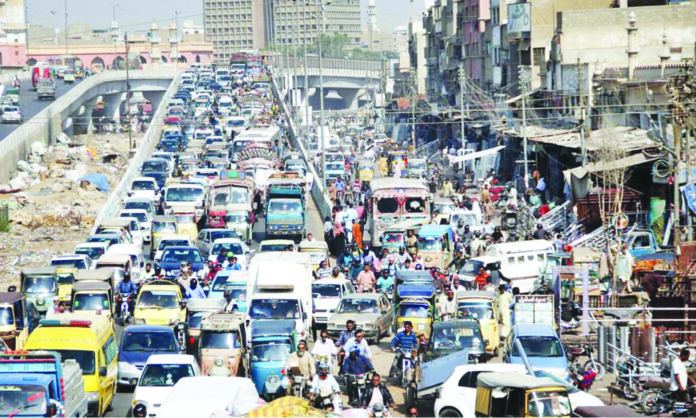Pakistan is one of the fastest urbanising countries in South Asia and the share of urban population has risen from 17 percent in 1951 to 37 percent in 2010, and to 41.7 percent in 2021 with annual rate of urban change at 2.79 percent. Projections show that in the next 5 years half of the population will be living in urban areas. Population growth and net migration are the major forces behind urban growth. About one-fifth of the annual rise in urban population can be attributed to net migration. Large cities with a population of one million and above had a share in the total population of 50 percent in 1998 which by now have risen to at least 66 percent or more. Urban areas contribute 80 percent of GDP, almost all the country’s tax revenues, and account for 60 percent of the employed labour force. Urban poverty rate is almost one half of that of the rural poverty rate. Per capita income levels and growth rates have also been relatively higher in the urban areas. Literacy and Enrolment ratios for both males and females are also better.
Pakistan’s public policy towards urbanization is characterized by sporadic spurts of enlightened political leaders, lacking foundational stability or consistent planning and execution. Large urban conglomerates in Pakistan have a poor picture, with between 35 and 50% of the urban population living in Katchi Abadis. In Karachi, there are 500 informal settlements, while in Lahore, more than 300. Islamabad has been spared this agony due to the main guiding instrument of a 60-year-old master plan, with few deviations.
Lahore has seen growth due to personal interest from successive Chief Ministers over the last 15 years, while Sialkot has seen local citizens and businesses create infrastructure without government involvement. Karachi, which had its own City District Government structure between 2002-2008, experienced better governance but has since suffered from neglect due to the abolishment of the City District Government and Town Councils. Land, water, transport
mafias, and criminal gangs have become dominant, leading to a highly polarized, deeply contested, and unliveable metropolis.
Urban sprawl in Islamabad, Quetta, Faisalabad, and Rawalpindi is a concerning issue, with Peshawar, Gujranwala, Hyderabad, and Sukkur being the worst examples. While Multan has made some progress in infrastructure development, the country faces a small business sector, high job scarcity, and limited economic opportunities. Urbanization has both positive and negative aspects, but if not addressed, it can lead to dangerous consequences that outweigh its positive aspects.
Pakistan is on the brink of a major demographic transition, with Lahore’s population expected to rise by 17.18 million by 2035, and Karachi’s to reach 23.17 million by 20.31 million. Urban development has shifted from public land to privileged classes, making land an important means for earning money. This unjustified process has created inequalities in urban centers, and low-income communities are not playing a significant role in determining the fate of urban cities. The shift from rural to urban areas in Pakistan is closely linked to the economy. Agriculture, which accounted for half of the country’s GDP in 1949-50, decreased to 24% of GDP in 2020-21. The manufacturing sector increased to 29%, while the services sector reached 55%. The agriculture sector, which accounted for 65% of the labour force, declined to 38% in 2020. The rise in urban populations has increased the demand for employment in urban areas. Major cities in Pakistan face a housing deficit of 5 million units, with nearly 50% of urbanites living in slums. Infrastructure deficit is a major indicator of urban decay.
Pakistan ranks 69th out of 125 countries in basic infrastructure, causing economic constraints and reduced growth potential. The World Bank’s 2016 report suggested increasing infrastructure development investment from 3% to 10% of GDP through policy interventions and improved regulations. Pakistan needs an urban development policy addressing infrastructure, improvised basic facilities, and community-based services to attract private sector and foreign investors. Addressing the chronic imbalance between demand and supply of infrastructure facilities is crucial for Pakistan’s economic growth.
Urban decay in Pakistan is characterized by low employment rates, unstable economic growth, incapable entrepreneurship, and weakening civilian institutions. The fastest growth
rate is among the 15-25-year-olds, and while urban areas have a high education ratio, finding employment is challenging. This lack of employment leads to emotional distress, disappointment, and street violence, contributing to unemployment and lack of opportunities for youth. The country also faces challenges in embracing diversity in views and virtues for the future. Conservatives advocate for economic growth without considering cultural evolution, while pragmatists view cultural evolution as a natural outcome of urbanization. This lack of tolerance towards divergent views hinders growth and development in urban Pakistan.
The Planning Commission of Pakistan has proposed a new economic growth paradigm, urging the country to take ownership of urbanisation. The commission suggests revising city zoning laws to allow for more high-rises and mixed-use buildings, generating more housing units, opening up space for schools, shops, and markets, and increasing service supply and commercial activity. However, creating an appropriate urban policy requires creativity and judiciousness, as it must balance industrial growth with the basic needs of city populations. Addressing this demographic transition is crucial to prevent overflowing cities with homeless and unemployed residents.























